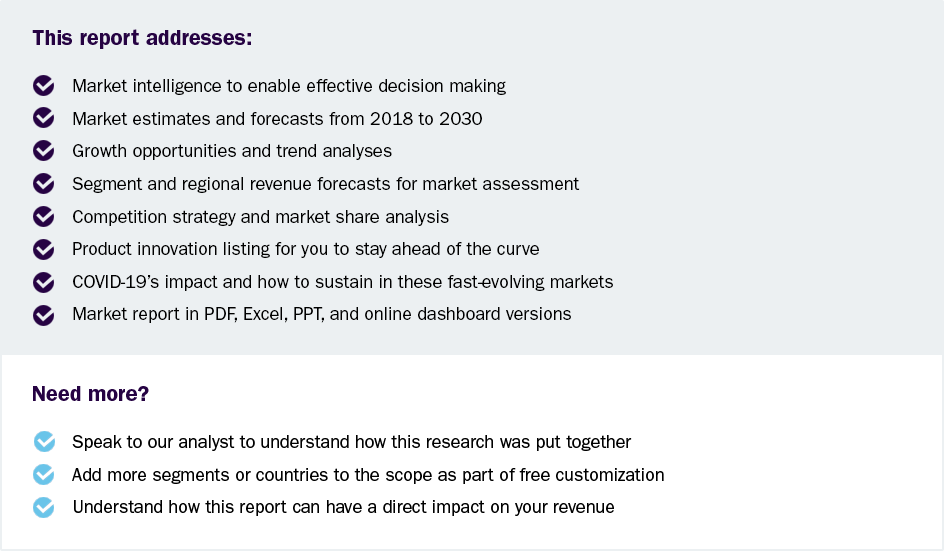
Pet Dewormers Market Size, Share & Trends Analysis Report By Pet (Dogs, Cats), By Dosage Form (Liquids, Tablets), By Route Of Administration, By Type, By Distribution Channel, By Region, And Segment Forecasts, 2025 - 2030
- Report ID: GVR-4-68040-504-0
- Number of Report Pages: 150
- Format: PDF, Horizon Databook
- Historical Range: 2018 - 2023
- Forecast Period: 2023 - 2030
- Industry: Healthcare
Pet Dewormers Market Size & Trends
The global pet dewormers market size was estimated at USD 2.44 billion in 2024 and is projected to grow at a CAGR of 8.61% from 2025 to 2030. Some key factors driving the market growth are awareness and education efforts regarding parasitic worms, the growing importance of parasite control in pets, the emergence of new parasitic worms, and growing R&D initiatives. Industry experts like veterinarians and researchers have, in recent years, increased their efforts to spread proper structured education among pet owners regarding the importance, facts, and myths regarding the deworming of pets such as dogs, cats, horses, etc. These efforts are being taken through diverse mediums like blogs, research articles, news releases, etc.
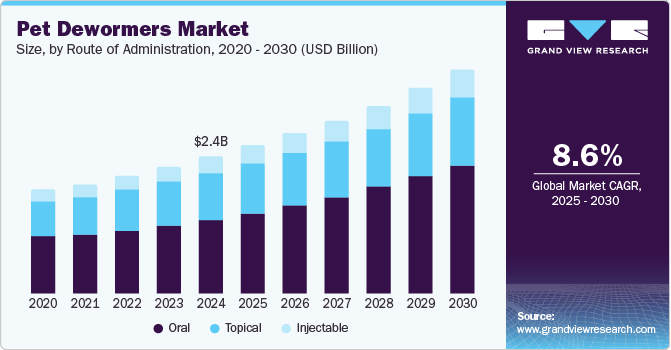
For instance, in VetHelpDirect, a prominent veterinary education and awareness institution in the UK, in its June 2024 article, discussed the concerns related to over-worming of pets, particularly cats and dogs, considering the variety of helminths like roundworms and tapeworms that can infect them. It emphasized the need for tailored deworming strategies for individual pets and proposed to avoid a one-size-fits-all approach as much as possible. The cases of anti-helminthic resistance can be observed commonly in companion animals like horses and livestock animals like cattle, sheep, pigs, etc.
Whereas, when it comes to cats and dogs, this resistance has not been widely observed yet; but experts believe that it may largely vary depending on the geographical location of the pet. In addition, the article also highlighted the possible zoonotic risks associated with certain parasites, underscoring the need for responsible deworming practices to protect both animal and human health. This showcases the need for a more educated and case-specific approach to parasite management in pets.
Furthermore, Virbac & Royal Canin, leading veterinary companies in the world, publish regular blogs for the purposes of spreading awareness and education among the masses. For example, a recent blog by Virbac India talked about the side effects of these deworming medications. While deworming medications are generally considered safe, at times, they cause mild and temporary side effects like vomiting, diarrhea, fatigue, loss of appetite, and allergic reactions, usually in puppies. These side effects commonly last from a few hours to a day, and experts recommend pet owners actively monitor their dogs closely during this period.
Overall, the blog presses on the crucial impact of regular deworming in pets while emphasizing expert veterinary guidance in establishing appropriate deworming schedules to lessen avoidable side effects. Another article published by Royal Canin in November 2023 emphasized on importance of deworming puppies to shield them from various intestinal parasites that can be acquired through environment or from their mother. The article further highlights that deworming schedule for puppies as early as two weeks old, which has been tailored by a veterinarian. Overall, such blogs and articles serve as guidelines for the pet owners and ultimately increase the demand for deworming medications.
Market Concentration & Characteristics
The degree of innovation in this market is estimated to be moderate owing to growing research initiatives to understand the parasitic worms anatomy & physiology and develop more effective treatment solutions. For example, in May 2024, researchers at University of Liverpool, in collaboration with St Andrews University and science photographer Dr David Maitland, captured and analyzed ultra-detailed images of parasitic worms from over 1,000 fecal samples from cat owners.
The industry is experiencing a low level of M&A activities. The main focus of veterinary experts and market players alike is on spreading education and awareness about importance of deworming in pets while also highlighting the need for a structured approach for the same.
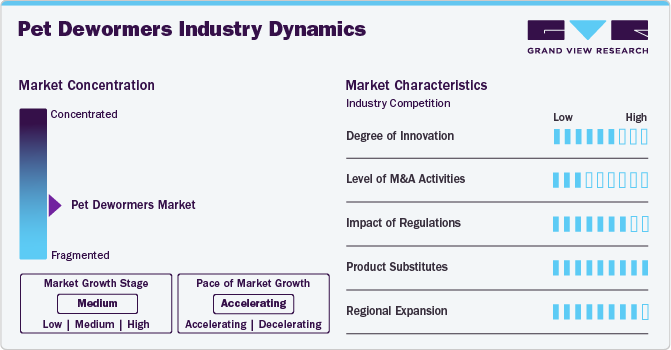
The impact of regulations is anticipated to be moderate to high. Regulatory authorities around the world are focusing on controlling the unnecessary over-the-counter dispensing of deworming medications to prohibit their misuse and inhibit the potentially growing cases of drug resistance.
The industry has a high number of product substitutes. Apart from a few leading products from companies like Zoetis, Elanco, and Boehringer Ingelheim, majority of the other products available in the market are manufactured by domestic companies, varying from country to country. This increases the variety of product substitutes, affecting the impact of leading brands.
The industry is experiencing a moderate impact of regional expansion. Industry leaders are engaged in conducting expansive surveys to understand the overall demographics of parasitic worm infections in pets and gauge the awareness among pet owners and veterinarians alike to further formulate an industry expansion strategy.
Pet Insights
The dogs segment held a significant share of around 37% in 2024. This can be attributed to multiple factors like higher population and adoption, higher expenditure on healthcare, and comparatively higher prevalence of parasitic worms in comparison to cats. For instance, according to multiple research articles from 2024 & 2025, across various countries like the U.S., Finland, Serbia, and Ethiopia, highest prevalence of parasitic worms in dogs was recorded at 60%, 5.9%, 62.6%, and 23.03% respectively.
The cats segment is anticipated to grow at the fastest CAGR from 2025 to 2030. This is expected to be driven by evolving regulatory guidelines related to feline parasitic worms. Regulatory authorities are in a continuous process of reviewing and updating guidelines regarding treatment of parasitic worm infections like heartworms to assist in better diagnosing and managing these conditions in cats. For instance, in November 2024, American Heartworm Society (AHS) updated its existing “Feline Heartworm Guidelines”, which was last revised in 2015, with an aim to address the underdiagnosis and undermanagement of this condition in cats. They focus on establishing a routine heartworm screening by utilizing both antigen and antibody tests in combination with other diagnostic techniques. In addition, year-round heartworm prevention and vector control to reduce mosquito exposure are the two factors highlighted by AHS for enhancing overall feline health and treatment outcomes.
Route of Administration Insights
By route of administration, the oral segment held the highest market share in 2024 and is anticipated to grow at the fastest CAGR of 9.61% over the forecast period. This route is generally preferred over injectable methods due to its ease of administering and effectiveness in delivering the medication directly to the intended target area, i.e., the gastrointestinal region, where most parasitic worms in pets reside.
They typically have a broader spectrum of action and tend to have higher compliance and palatability, as they can be mixed with water/food, reducing stress during administration. In addition, oral medications minimize the risk of complications associated with injections, like reactions or infections, making them a more convenient option for both pet owners and veterinarians.
Dosage Form Insights
The liquids segment held the largest revenue share in 2024. This segment includes medications like semi-solid topical and oral as well as injectable liquids. The dominance can be attributed to the ease of administration of this dosage by mixing the drug with the water or administering it direct on the surface of the tongue. Furthermore, in need of a more direct administration and to gain higher drug bioavailability, veterinarians can easily administer injectable dewormer drugs like praziquantel and fenbendazole.
The tablets segment is expected to grow at the fastest CAGR over the forecast period. This can be attributed to their accurate and controlled dosage and, as it can be easily disguised in food or given as treats, increasing its palatability for pets who might resist liquid formulations. In addition, tablets generally have longer shelf life and, therefore, are prone to less spoilage compared to liquid medications. Furthermore, chewable/flavored tablet options enhance acceptance among pets.
Type Insights
The prescription segment dominated in terms of market share in 2024 and is expected to grow at the fastest CAGR over the forecast period. Majority of the deworming drugs are prescription only and can only be administered under the supervision of a veterinarian. This is due to the fact that these medications can cause many debilitating side effects like vomiting, diarrhea, fatigue, loss of appetite, and allergic reactions. In addition, in recent years, many cases of developing drug resistance have been observed across species like horses, dogs, and cats.
This drug resistance can be attributed to uncontrolled and over-the-counter use of these deworming medications. To tackle these issues, regulatory authorities are increasingly being engaged in controlling the use of dewormers, only to be used under the supervision of veterinarians, by making it prescription-only. These factors are contributing to the growth of this segment.
Distribution Channel Insights
The veterinary hospitals/clinics segment led the market in 2024 in terms of revenue share. The veterinary hospital/clinics are very crucial for pet healthcare as they help pet owners understand the proper dosage of medicine with timely diagnosis. As most parasiticide brands need mandatory veterinary observation before usage, the admission rates in veterinary clinics have significantly increased. For instance, some famous dog dewormer brands such as Panacur, Drontal Plus, NexGard, Advantix (Elanco) require a standard veterinarian prescription before drug usage.
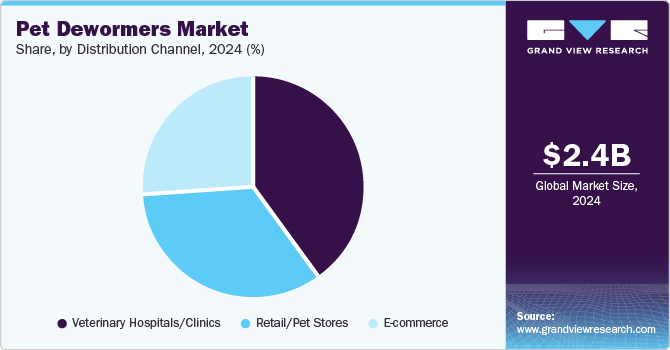
The E-commerce segment is expected to grow at the fastest rate of over 10.12% over the forecast period. Online sales of dog dewormer products have grown widely during the COVID-19 pandemic. E-commerce has become a convenient and easily accessible platform for pet care products. These online platforms provide a wide range of dewormers in different flavors, sizes, and quantities at an affordable price. Common e-commerce sites like Chewy, Amazon, Nappets, and Miscota supply a huge range of dewormers in form of tablets, liquid, and chews for multiple dog sizes & breeds. Moreover, constant updates with respect to the launch of new products, promotional sales, and positive product reviews about existing products enhance consumer trust to buy these products via online channels. In addition, industry giants like Zoetis and Elanco are also entering the e-commerce platforms to better offer their product portfolios.
Regional Insights
The North America pet dewormers market held more than 35% of the global revenue share in 2024. The dominance can be attributed to regulatory authorities taking active efforts to upgrade the existing guidelines for better diagnosis, treatment, and management of parasitic infections in animals like dogs & cats. For instance, in May 2024, the AHS updated its “Canine Heartworm Guidelines” with a focus on a year-round administration of macrocyclic lactone as an essential preventive medication for heartworm management. The revised guidelines also recommended FDA-approved isoxazolines and EPA-approved mosquito repellents to help the diseases’ spread. AHS also underlines the importance of annual antigen and microfilaria testing of dogs and employment of alternative treatment protocols for heartworm-positive patients when optimal treatment is not feasible.
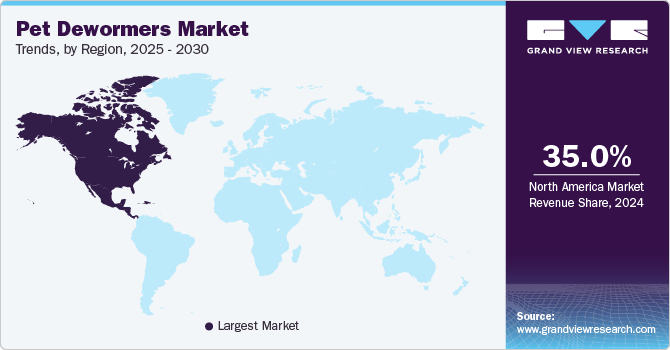
U.S. Pet Dewormers Market Trends
The pet dewormers market in the U.S. is set to experience lucrative growth due to the emergence of new and fatal parasitic worms in the country. For instance, a March 2024 article from Live Science reported the emergence of a new parasitic worm capable of killing dogs in the areas of the Gulf Coast and South Atlantic states of the U.S., like Colorado, Arizona, and California. This worm is called Heterobilharzia americana and is responsible for causing canine schistosomiasis.
Europe Pet Dewormers Market Trends
The Europe pet dewormers market growth can be attributed to efforts taken by leading veterinary institutions in the region to address leading myths surrounding pet deworming and debunking them to spread necessary education. For instance, in November 2024, the UK’s leading veterinary charity, The People's Dispensary for Sick Animals or the PDSA, debunked many common myths about flea and worming treatments in pets, emphasizing that all pets, including indoor ones, require regular parasite treatments regardless of their environment. It clarified that a singular treatment is insufficient for long-standing protection and warned against using a common treatment for both cats and dogs due to potential toxicity. In addition, the article identified that parasites could survive in colder months, making year-round prevention essential. Overall, the blog stressed the importance of consulting a veterinarian for tailored treatment plans to ensure pets remain healthy and parasite-free.
The UK pet dewormers market is experiencing lucrative market growth due to growing efforts to structure and upgrade regulatory guidelines surrounding veterinary medicines. For instance, in January 2024, the UK regulatory authorities implemented a new legislation for dispensing flea and worming drugs for pets. Under this legislation, a physical examination is required prior to dispensing prescription-only medications (POM-V). As per the previous law, veterinarians were allowed to prescribe these medications for around 12 months without the need for follow-up visits, but as per these updated legislations, the pet owner is required to physically visit the veterinarian.
The Ireland pet dewormers market growth can be attributed to the primary factor that lungworms are the most common parasite spreading across dogs in Ireland. This causes blood clotting and breathing difficulties, which might lead to life-threatening problems such as heart failure in dogs. According to Acorn Veterinary Clinic, pet owners in Ireland are recommended to deworm their adult dogs once every 3 months. The Ireland’s national animal welfare charity called, ISPCA (Irish Society for Prevention of Cruelty to Animals), rescues and treats animals medically to enhance animal healthcare in the country. The organization holds 17 local welfare affiliates to improve their number of volunteers. They also raise people’s awareness through various education programs regarding infections among dogs and the importance of deworming and vaccinations to promote their health.
Asia Pacific Pet Dewormers Market Trends
Asia Pacific pet dewormers market is anticipated to witness a significant growth rate of over 9.8% over the forecast period. This can be attributed to the emergence of potential zoonotic transmission of parasitic worms from pets to humans in the region. For instance, in January 2024, an individual from Hanoi, Vietnam, contracted a roundworm infection, causing multiple health complications. It was revealed after thorough medical examinations that he was suffering from dog roundworm infection. The likely reason was noted to be the fact that he slept with the dogs and cared for them for years. Such cases highlight the importance of timely diagnosis, treatment & management of parasitic worm infections in pets.
The pet dewormers market in Australia is primarily driven by growing research efforts by the country’s scientists to discover crucial and potentially disruptive insights into the mechanism of action of deworming drugs on pets. For instance, as per a January 2025 published article from Science Daily, a study conducted by researchers from the University of Queensland, Australia, revealed that canine hookworms found in Australian pets are becoming increasingly resistant to benzimidazole-based dewormers. Nearly 70% of samples that were tested displayed genetic mutations linked to this resistance, posing a significant risk to both pets and humans, as these infections can lead to serious health issues, including anemia and cutaneous larva migrans in people. The study highlights for a shift towards a targeted, risk-based treatment approach towards managing veterinary parasites effectively and curbing the spread of resistance.
Latin America Pet Dewormers Market Trends
The market for pet dewormers in Latin America is expected to show lucrative growth due to rising parasitic diseases among dogs in the regions countries like Chile. A December 2022 study by UC Davis One Health Institute and School of Veterinary Medicine highlighted the fact that a rise in parasitic infections in parts of Chile can be found since 2004. The study claimed this occurrence was due to cancellation of a government deworming program in 2004 in the country’s province of Tierra del Fuego. This initiative reduced the prevalence of the province’s dogs from 68.4% in 1978 to 1.2% in 2002. The prevalence was noted to be increasing to about 6.9% as of 2016 since the closure of the initiative in 2004.
The pet dewormers market in Brazil is expected to exhibit steady growth during the forecast period. Leading domestic players in the country are involved in educating and attempting to increase the adoption of deworming drugs in the country. For instance, Biovet, a prominent domestic veterinary products company in Brazil, publishes blogs about the potential risks of parasitic worm infections in pets, and deworming guidelines to effectively treat and manage these infections.
MEA Pet Dewormers Market Trends
The pet dewormers market in the Middle East and Africa is driven by the emergence of collaborative research efforts in the region. Multiple veterinary academic & research institutions across countries like Egypt and Saudia Arabia are collaborating to assess and put into spotlight the epidemiological data of regional animal populations. For instance, according to a January 2023 article published in MDPI, a joint study to explore the prevalence of gastrointestinal parasites was conducted by various research institutions across Egypt & Saudi Arabia. The study explored the prevalence of gastrointestinal parasites in dogs from Dakahlia Governorate of Egypt, showcasing a significant prevalence of Toxocara canis and other parasites, i.e., around 24.7%. The study inferred the need for ongoing monitoring and effective deworming strategies to manage these parasitic infections in canine populations across Egypt.
The pet dewormers market in South Africa can be attributed to growing international efforts to effectively diagnose, treat, and manage health complications in stray dogs and cats. For instance, in April 2024, on the occasion of World Stray Animal Day, the Humane Society International/Africa initiated various health campaigns to address health complications in over 4 million stray dogs & cats in areas of Struisbraai & Bredasdorp in South Africa.
Key Pet Dewormers Company Insights
The current focus of the market players, veterinarians, and veterinary organizations alike is to spread proper education among the pet owners to ensure the timely and preventive management of parasitic worm infections in pets in done. Apart from this, these industry participants are engaging in activities like research and development, regulatory approvals, scrutiny and upgradation, exploring novel treatment applications, product/ service launches, regional expansions, etc.
Key Pet Dewormers Companies:
The following are the leading companies in the pet dewormers market. These companies collectively hold the largest market share and dictate industry trends.
- Zoetis
- Boehringer Ingelheim
- Merck & Co. Inc.
- Dechra Pharmaceuticals Plc.
- Elanco Animal Health
- Ceva Sante Animale
- Virbac
- Vetoquinol
- Hester Biosciences Limited
- Intas Pharmaceuticals Ltd.
View a comprehensive list of companies in the Pet Dewormers Market.
Recent Developments
-
In October 2024, the US FDA approved Credelio Quattro, a drug by Elanco Animal Health. This drug is a chewable, oral tablet that can protect dogs more than 8 weeks old from over six parasitic infections caused by fleas, ticks, roundworm, hookworm, tapeworm, and heartworm.
-
In April 2024, the California Department of Fish and Wildlife issued an advisory telling pet owners to be cautious of potential parasitic flatworm infection that can spread from raw ingestion of certain species of fish like salmon and trout by their pets.
-
In March 2023, a study conducted by researchers at the University of Calgary revealed that drug resistance among canine hookworms is widespread across the U.S., with over 50% of infected dogs carrying these resistant parasites.
Pet Dewormers Market Report Scope
|
Report Attribute |
Details |
|
Market size value in 2025 |
USD 2.64 billion |
|
Revenue Forecast in 2030 |
USD 3.98 billion |
|
Growth rate |
CAGR of 8.61% from 2025 to 2030 |
|
Base year for estimation |
2024 |
|
Historical data |
2018 - 2023 |
|
Forecast period |
2025 - 2030 |
|
Quantitative units |
Revenue in USD million/billion, and CAGR from 2025 to 2030 |
|
Report Coverage |
Revenue forecast, company ranking, competitive landscape, growth factors, and trends |
|
Segments Covered |
Pet, route of administration, dosage form, type, distribution channel, region |
|
Regional scope |
North America, Europe, Asia Pacific, Latin America, MEA |
|
Country scope |
US, Canada, Mexico, Spain, Germany, Portugal, Romania, Slovakia, Czech, Hungary, Poland, Italy, Ireland, UK, France, Denmark, Sweden, Norway, Japan, China, India, Australia, Thailand, South Korea, Brazil, Argentina, South Africa, Saudi Arabia, UAE, and Kuwait |
|
Key companies profiled |
Zoetis, Boehringer Ingelheim, Merck & Co. Inc., Dechra Pharmaceuticals Plc., Elanco Animal Health, Ceva Sante Animale, Virbac, Vetoquinol, Hester Biosciences Limited , and Intas Pharmaceuticals Ltd. |
|
Customization scope |
Free report customization (equivalent up to 8 analysts working days) with purchase. Addition or alteration to country, regional & segment scope. |
|
Pricing and purchase options |
Avail customized purchase options to meet your exact research needs. Explore purchase options |
Global Pet Dewormers Market Report Segmentation
This report forecasts revenue growth at global, regional, and country levels and provides an analysis of the latest industry trends in each of the sub-segments from 2018 to 2030. For this study, Grand View Research has segmented the global pet dewormers market report based on pet, route of administration, dosage form, type, distribution channel, and region:
-
Pet Outlook (Revenue, USD Million, 2018 - 2030)
-
Dogs
-
Cats
-
Horses
-
Other Pets
-
-
Route of Administration Outlook (Revenue, USD Million, 2018 - 2030)
-
Oral
-
Injectable
-
Topical
-
-
Dosage Form Outlook (Revenue, USD Million, 2018 - 2030)
-
Liquids
-
Tablets
-
-
Type Outlook (Revenue, USD Million, 2018 - 2030)
-
OTC
-
Prescription
-
-
Distribution Channel Outlook (Revenue, USD Million, 2018 - 2030)
-
Veterinary Hospitals/Clinics
-
Retail/Pet Stores
-
E-commerce
-
-
Regional Outlook (Revenue, USD Million, 2018 - 2030)
-
North America
-
U.S.
-
Canada
-
Mexico
-
-
Europe
-
Spain
-
Germany
-
Portugal
-
Romania
-
Slovakia
-
Czech
-
Hungary
-
Poland
-
Italy
-
Ireland
-
UK
-
France
-
Denmark
-
Sweden
-
Norway
-
Rest of EU
-
-
Asia Pacific
-
Japan
-
China
-
India
-
Australia
-
Thailand
-
South Korea
-
Rest of APAC
-
-
Latin America
-
Brazil
-
Argentina
-
Rest of LA
-
-
Middle East and Africa (MEA)
-
South Africa
-
Saudi Arabia
-
UAE
-
Kuwait
-
Rest of MEA
-
-
Frequently Asked Questions About This Report
b. The global pet dewormers market size was estimated at USD 2.44 billion in 2024 and is expected to reach USD 2.64 billion in 2025.
b. The global pet dewormers market is expected to grow at a compound annual growth rate of 8.6% from 2025 to 2030 to reach USD 3.98 billion by 2030.
b. The North America pet dewormers market held more than 35% of the global market 2024. The dominance can be attributed to regulatory authorities taking active efforts in upgrading the existing guidelines for better diagnosis, treatment and management of parasitic infections in animals like dogs & cats.
b. Some key players operating in the pet dewormers market include Zoetis, Boehringer Ingelheim, Merck & Co. Inc., Dechra Pharmaceuticals Plc., Elanco Animal Health, Ceva Sante Animale, Virbac, Vetoquinol, Hester Biosciences Limited , and Intas Pharmaceuticals Ltd.
b. Some key factors driving the market growth are awareness and education efforts regarding parasitic worms, growing importance of parasite control in pets, emergence of new parasitic worms, and growing R&D initiatives.
We are committed towards customer satisfaction, and quality service.
"The quality of research they have done for us has been excellent."

